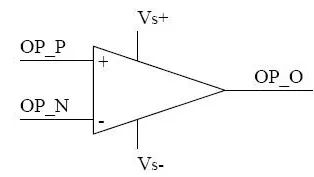Overview
An operational amplifier (op amp) is a fundamental electronic component widely used in analog circuits. Typical characteristics include:
Key characteristics
- High gain: Op amps have very high open-loop gain, often reaching tens of thousands. This allows them to amplify very small input signals.
- High input impedance: The input terminals present very high impedance, so they draw negligible input current and minimally load the signal source.
- Low output impedance: The output stage has low impedance and can supply current to drive various loads.
- Virtual short property: In the ideal case the input resistance is infinite and input currents are zero. Practically, inputs have very high resistance and very low input currents, and under negative feedback the input terminals behave as if they are at the same voltage (virtual short).
- Wide applicability: Op amps are used in many circuits, including comparators, filters, amplifiers, integrators, and differentiators.
- Feedback networks: Op amps are typically used with feedback networks to set gain, bandwidth, and stability.
An ideal op amp would have infinite input impedance, zero output impedance, infinite open-loop gain, infinite common-mode rejection ratio, and infinite bandwidth.

Why negative feedback is common
In typical configurations the output is fed back to the inverting input to form negative feedback. Because op amps have very high voltage gain, from hundreds to tens of thousands, negative feedback is used to ensure stable and predictable circuit behavior. That said, positive feedback is also used in designs that require oscillation or hysteresis.
Distinguishing the inputs
- Noninverting input (+): In schematic symbols this terminal is marked with a "+". It receives the input signal reference and is generally used for the noninverted input path, often connected to the signal source or input circuitry.
- Inverting input (-): Marked with a "-" in symbols. It is commonly used for the feedback path or connected to ground in certain configurations. In negative feedback circuits the inverting input receives the feedback that controls the amplifier's gain and performance.
Practical note
Correctly identifying and wiring the noninverting and inverting inputs is essential for proper operation and to achieve the intended amplification and signal processing functions.
 ALLPCB
ALLPCB






